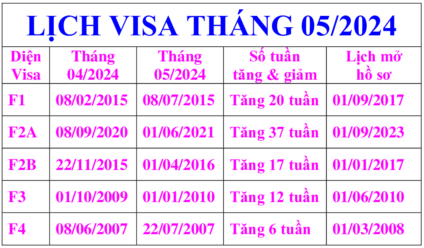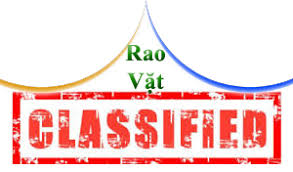Theo bản báo cáo mới nhất của Ban Nghiên Cứu Quốc Hội Hoa Kỳ, Việt Nam đứng hàng thứ tư trong danh sách của những quốc gia có đông người di dân nhất đang chờ đợi để sang Hoa Kỳ theo các diện bảo lãnh thân nhân gia đình.
Hiện tổng cộng có 155.000 di dân đang chờ đợi duyệt xét theo diện bảo lãnh theo thứ tự ưu tiên, bao gồm 6.400 con của các công dân Mỹ, 8.700 con độc thân của thường trú nhân, 64.000 con đã có gia đình của các công dân Mỹ, và 170.000 anh chị em của các công dân Hoa Kỳ.
Để nhìn lại một năm vấn đề di dân của người Việt Nam, chúng ta sẽ duyệt lại những thay đổi trong những điều luật di trú đã xảy ra trong năm 2014 và ảnh hưởng đến cộng đồng Việt Nam ra sao.
Những sự thay đổi mới nhất và quan trọng nhất đã xảy ra vào cuối tháng 11 năm 2014 khi Tổng thống Obama loan báo về Tác Động Hành Pháp của ông. Vấn đề này bao gồm:
– Nới thêm số tuổi của những người hợp lệ chương trình Tạm Hoãn (Thi Hành Lệnh Trục Xuất) Của Những Người Đến (Hoa Kỳ) Từ Thơ Ấu (tức Deferred Action for Childhood Arrivals, gọi tắt là DACA), bao gồm những người đến Mỹ trước 16 tuổi và hiện đang ở Hoa Kỳ từ ngày 1 tháng Giêng năm 2010; tăng thời gian của chương trình DACA và giấy phép được làm việc tăng từ 2 năm đến 3 năm. Thời gian duyệt xét bắt đầu từ tháng Hai năm 2015.
– Cho phép cha mẹ của các công dân Mỹ và thường trú nhân từng ở Hoa Kỳ từ ngày 1 tháng Giêng năm 2010 được tạm hoãn thi hành lệnh trục xuất và được quyền làm việc trong 3 năm theo chương trình Tạm Hoãn (Thi Hành Lệnh Trục Xuất) Vì Trách Nhiệm Cha Mẹ (tức Deffered Action for Parental Accountability program, gọi tắt là DAPA). Những người này phải qua kiểm tra lý lịch cá nhân. Đơn sẽ được Sở di trú chính thức nhận từ tháng Năm 2015.
– Mở rộng thêm lợi ích cho những người được miễn trục xuất tạm thời vì cư ngụ bất hợp pháp, bao gồm người hôn phối và các con của các thường trú nhân và các con của công dân Hoa Kỳ, và
– Nhẹ nhàng hơn với những đòi hỏi cần chứng minh hoàn cảnh “vô cùng khó khăn”.
Vấn đề con nuôi:
Vào tháng 9 năm 2014 sau 6 năm thương lượng, Hoa Kỳ và Việt Nam sau cùng đã thành hình một Hiệp Định Con Nuôi mới. Hiệp định con nuôi mới này được gọi là Chương Trình Con Nuôi Đặc Biệt và cho phép việc nhận con nuôi theo ba loại trẻ em sau đây:
– Trẻ em với tình trạng y tế không tốt, chẳng hạn như bị bệnh liệt kháng HIV, và những trẻ em bị tàn tật,
– Trẻ em ít nhất từ 5 tuổi và đến 15 tuổi,
– Trẻ em trong nhóm có nhiều anh em ruột, từ hai em trở lên, và ít nhất trong số này phải có em dưới 16 tuổi.
Sự thay đổi quan trọng thứ hai trong Chương Trình Con Nuôi Đặc Biệt là những em này sẽ được chọn bởi nhà nước Việt Nam. Điều này có nghĩa là các cơ quan của nhà nước Việt Nam sẽ cung cấp cho những cha mẹ muốn nhận con nuôi những thông tin về một hoặc nhiều trẻ em hợp lệ để được nhận làm con nuôi. Cha mẹ nuôi có thể chọn một trong những em này hoặc từ chối tất cả.
Thay đổi quan trọng thứ ba là chỉ có hai văn phòng con nuôi ở Hoa Kỳ có thể tham dự Chương Trình Con Nuôi Đặc Biệt. Hai văn phòng này là Dillon International và Holt International Children’s Services. Chỉ có hai văn phòng này có thể làm việc trực tiếp với nhà nước Việt Nam trong việc duyệt xét những hồ sơ con nuôi.
Luật Bảo Vệ Tuổi Trẻ Em (CSPA):
Vào tháng 6 năm 2014, Tối Cao Pháp Viện Hoa Kỳ – một cách bất ngờ và thật đáng buồn, đã từ chối việc thay đổi Luật Bảo Vệ Tuổi Trẻ Em. Họ nói rằng vấn đề này thuộc về quốc hội. Vì thế, nhiều trẻ em trên 21 tuổi của hai diện bảo lãnh F3 và F4 phải đợi cho đến khi cha mẹ đến Hoa Kỳ và nộp đơn bảo lãnh các em theo diện F2B.
Liệu chúng ta có thể kỳ vọng về việc Cải Tổ Di Trú trong năm 2015 không? Đây là vấn đề thuần túy chính trị. Sẽ có sự cải tổ rõ rệt nếu các dân biểu thấy rằng điều này sẽ mang lại nhiều phiếu bầu hơn để giữ chân họ trong nghị trường. Tác Động Hành Pháp của Tổng thống Obama chỉ là thước đo tạm thời. Để đạt được việc cải tổ di trú thực sự sẽ đòi hỏi hành động cụ thể của quốc hội.
Diện bảo lãnh F2A dành cho vợ-chồng và con độc thân dưới 21 tuổi của các Thường trú nhân tiếp tục tiến nhanh với thời gian chờ đợi khoảng một năm rưỡi để hồ sơ đáo hạn.
Diện bảo lãnh F2B dành cho các con độc thân và trên 21 tuổi của các Thường trú nhân vẫn phải đợi trên 5 năm, nhưng ngày đáo hạn của diện này hiện cũng tiến rất nhanh.
Thống kê mới nhất cho thấy Hoa Kỳ đã thu nhận số sinh viên quốc tế du học cao nhất trong lịch sử, đã đón nhận 819,644 sinh viên chưa tốt nghiệp và sinh viên hậu đại học vào các trường đại học khắp nơi đến đất Mỹ. Sinh viên đến từ ngoại quốc đã thêm vào gần 24 tỷ Mỹ kim cho nền kinh tế Hoa Kỳ. Số sinh viên du học từ Trung cộng xin học tại các trường đại học ở Hoa Kỳ đã tăng gần 235,000 người.
Thẻ Xanh cho người đầu tư:
Số đơn chấp thuận chiếu khán EB-5 cũng tăng đáng kể, mặc dù thời gian duyệt xét lâu hơn thời gian bình thường là 13.8 tháng do Sở di trú quy định. Năm 2014 đã có 11,000 hồ sơ EB-5 nộp với sở di trú, bằng ¼ tổng số hồ sơ EB-5 từ khi chương trình được bắt đầu từ năm 1990. Ngòai ra cũng trong năm 2014, sở di trú đã nhận 2,500 đơn xin thẻ xanh dài hạn 10 năm (I-829), và 270 đơn xin thành lập trung tâm vùng (I-924). Sở di trú có kế họach xét 1,000 hồ sơ EB-5 một tháng kể từ đầu năm 2015.
Tóm lại, đến Hoa Kỳ vẫn là cách chọn lựa hàng đầu của hầu hết di dân, kể cả di dân người Việt Nam.
Hỏi Đáp Di Trú
– Hỏi: Những đương đơn hội đủ điều kiện có thể nộp đơn bây giờ dựa theo Tác Động Hành Pháp của Tổng thống Obama không?
– Đáp: Tác Động Hành Pháp chưa có thể thi hành bây giờ, và Sở di trú không nhận bất cứ yêu cầu hoặc đơn trong lúc này. Nên cẩn thận những người hứa hẹn sẽ giúp đỡ qúy vị nộp đơn hoặc yêu cầu nào đó liên quan đến Tác Động Hành Pháp trước khi thành luật cụ thể. Chương trình DACA mở rộng sẽ có hiệu lực trong tháng Hai năm 2015 và chương trình DAPA có hiệu lực trong tháng Năm 2015, và những thay đổi khác sẽ được loan báo sau đó.
– Hỏi: Các đương đơn sẽ phải đợi bao lâu để có thể biết quyết định về đơn của họ?
– Đáp: Với tất cả đơn nhận trong năm 2015, Sở di trú mong muốn hoàn tất thủ tục duyệt xét vào cuối năm 2016.
– Hỏi: Sở di trú có sẽ cần thêm nhân sự để thực hiện những công việc mới không?
– Đáp: Sở di trú sẽ cần phải điều chỉnh số nhân sự của họ để có thể hoàn tất công việc mới của họ một cách hữu hiệu. Điều này có nghĩa là họ sẽ phải mướn thêm hàng ngàn nhân viên để duyệt xét đơn liên quan đến hai chương trình DACA và DAPA, cũng như giải quyết những đơn về di trú và đơn bảo lãnh khác, chẳng hạn như đơn bảo lãnh gia đình và xin thẻ xanh.
===================================================
DHS/DOS Request for Information on Modernizing & Streamlining U.S.Immigrant & Nonimmigrant visa System
immigration-law.com
30/12/2014
As separate from the specific plans of immigration stakeholder agencies to implement the President’s Immigration Actions of November 20, 2014, the DHS and DOS are seeking a wide rage of information from the public to streamline and improve the Nation’s legal immigration system during the next 30 days. This announcement will be official published in the federal register tomorrow, 12/30/2014, but our readers can read the advance copy here.
Although it states that it is not directly related to the Obama actions, the subjects they seek public’s inputs are very similar to immigration actions for legal immigration systems in the Obama;s November 20, 2014 Immigration Actions announcement as people can see it below:
I. Streamlining the Legal Immigration System
1. What are the most important policy and operational changes that would streamline and improve the processing of immigrant visas at U.S. Embassies and Consulates, for both family-sponsored and employment-based immigrant visas?
2. What are the most important policy and operational changes that would streamline and improve the processing of nonimmigrant visas at U.S. Embassies and Consulates, including visitor, student, temporary worker and other nonimmigrant visas?
3. What are the most important policy and operational changes that would streamline and improve U.S. Citizenship and Immigration Services (USCIS) processing of the following types of immigrant and nonimmigrant visa petitions?
a. Family-sponsored immigrant visa petitions
b. Employment-based immigrant visa petitions
c. Nonimmigrant petitions
d. Humanitarian petitions and
applications (such as U nonimmigrant status petitions, T nonimmigrant status applications, and VAWA self-petitions)
e. H-1B temporary worker visa petitions, specifically, ways to reduce burdens on employers and workers engaging in the H-1B petition process, consistent with protections for U.S. and temporary foreign workers. (Note that employment authorization for certain H-4 dependent spouses of H-1 B nonimmigrants was a part of the President’s November 20 announcement described above, and recommendations regarding that topic should not be submitted here.)
4. What are the most important policy and operational changes that would streamline and improve the process of changing from one nonimmigrant status to another nonimmigrant status?
5. What are the most important policy and operational changes that would streamline and improve the process of applying for adjustment of status to that of a lawful permanent resident while in the United States?
6. What are the most important policy and operational changes that would streamline and improve the inspection of arriving immigrants and nonimmigrants at U.S. ports of entry?
7. What are the most important policy and operational changes that would attract the world’s most talented researchers to U.S. universities, national laboratories, and other research institutions? (Do not submit responses directly related to the actions announced on November 20, including the strengthening and extending of the Optional Practical Training program for foreign students. Separate processes exist to engage regarding those actions where necessary; see details above.)
8. What are the most important policy and operational changes that would attract the world’s most talented entrepreneurs who want to start and grow their business in the United States? (Do not submit responses directly related to the actions announced on November 20, including the “national interest waiver” and “significant public benefit” parole pathways for entrepreneurs. Separate processes exist to engage regarding those actions where necessary; see details above.)
9. What are the policy or operational changes that could assist in creating additional immigration opportunities for high-demand professions, such as physicians?
10. Focusing on the EB-5 immigrant investor visa, what policy or operational changes would
(a) reduce existing burdens and uncertainties on the part of petitioners, Regional Centers, and other participants in the program;
(b) ensure that this program is achieving the greatest impact in terms of U.S. job creation, economic growth, and investment in national priority projects that the capital markets would not otherwise competitively finance; and
(c) enhance protections against fraud, abuse, and criminal misuse of the program by petitioners or Regional Centers?
11. How can labor market related requirements for temporary workers be best tailored to meaningfully protect both U.S. and temporary foreign workers while achieving operational efficiency for both employers and relevant Federal agencies?
12. How should relevant occupational categories, descriptors, and/or data, such as the Department of Labor’s O*NET system (http://www.onetonline.org) be refined and updated to better align the prevailing wage determination process for visas with the evolving job market?
13. Focusing on the diversity visa program, what are the most important policy and operational changes that would streamline and improve the diversity visa process, including enhancing protections against fraud?
14. What other policy and operational changes would most effectively combat waste, fraud, and abuse in the legal immigration system
II. Ensuring Use of All Immigrant Visa Numbers
15. What are the most important policy and operational changes, if any, available within the existing statutory framework to ensure that administrative policies, practices, and systems fully and fairly allocate all of the immigrant visa numbers that Congress provides for and intends to be issued each year going forward?
16. What are the most important policy and operational changes, if any, available within the existing statutory framework to ensure that administrative policies, practices, and systems fully and fairly allocate all of the immigrant visa numbers that Congress provided for and intended to be issued, but were not issued in past years?
III. Modernizing IT Infrastructure
17. From the perspective of petitioners and applicants, which elements of the current legal immigration system (both immigrant and nonimmigrant systems) are most in need of modernized information technology (IT) solutions, and what changes would result in the most significant improvements to the user experience?
18. Which existing government-collected data and metrics would be most valuable to make available to the public, consistent with privacy protections and national security, in order to improve oversight and understanding of the legal immigration system?
Hmmm…………………… Interesting! Consdering the fact that they are seeking inputs within a short period of time of only 30 days and subjects look very similar to Obama actions list in legal immigrant system reform, they are still seeking final directions for reform of legal system part of the immigration reform, as separate from scheduled launch of reform of undocumented immigrant system reform beginning from May 2015. What do you think, readers? Legal immigrants, particularly employment-based immigrants, employers and stakeholders should en masse participate in the process!! Remember the old saying: Only crying babies are fed with milk!!
Do you remember that aside form the foregoing efforts of DHS and DOS (Department of State), the Department of Labor is also working on the following:
To respond to change, the Department will be initiating a review of the PERM program and relevant regulations. As part of this review, the Department will seek input on the current regulation, including how it could be modernized to be more responsive to changes in the national workforce. Specifically, the Department will seek input on the following:
Options for identifying labor force occupational shortages and surpluses and methods for aligning domestic worker recruitment requirements with demonstrated shortages and surpluses;
Methods and practices designed to modernize U.S. worker recruitment requirements;
Processes to clarify employer obligations to insure PERM positions are fully open to U.S. workers;
Ranges of case processing timeframes and possibilities for premium processing; and
Application submission and review process and feasibility for efficiently addressing nonmaterial errors.
ETA may also examine other aspects of the existing PERM regulations to further align the program design with the objectives of the U.S. immigration system and needs of workers and employers, and to enhance the integrity of the labor certification process.
Unlike the information on reform for the undocumented immigrants, legal immigrants are currently suffering from lack of information on the government reform efforts. Hope we see some improvement in this matter in the future.










